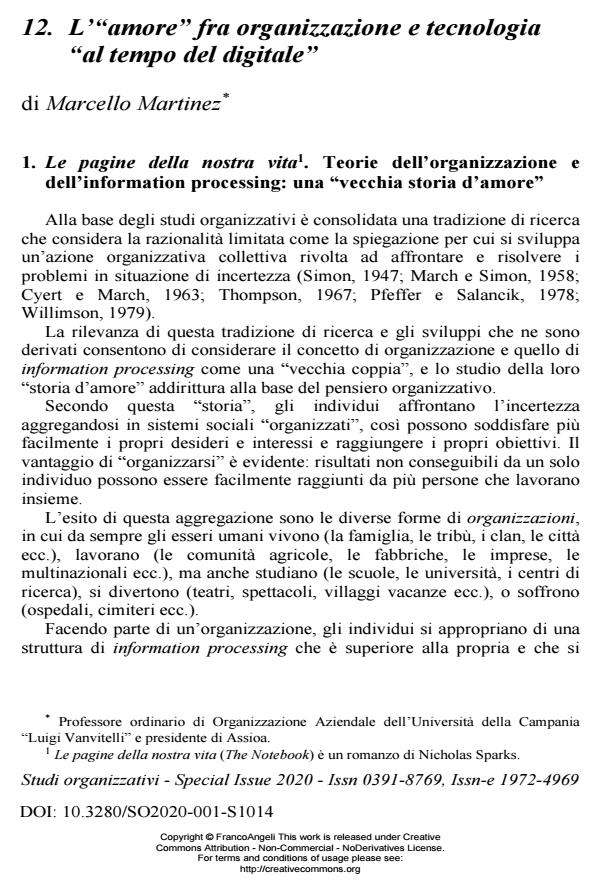L’"amore" fra organizzazione e tecnologia "al tempo del digitale"
Titolo Rivista STUDI ORGANIZZATIVI
Autori/Curatori Marcello Martinez
Anno di pubblicazione 2020 Fascicolo 2020/suppl. 1 Lingua Italiano
Numero pagine 9 P. 231-239 Dimensione file 213 KB
DOI 10.3280/SO2020-001-S1014
Il DOI è il codice a barre della proprietà intellettuale: per saperne di più
clicca qui

FrancoAngeli è membro della Publishers International Linking Association, Inc (PILA)associazione indipendente e non profit per facilitare (attraverso i servizi tecnologici implementati da CrossRef.org) l’accesso degli studiosi ai contenuti digitali nelle pubblicazioni professionali e scientifiche
- Caporarello L., Di Martino B., Martinez M. (2015). Smart Organizations and Smart Artifacts: Fostering Interaction Between People, Technologies and Processes. In: Caporarello L., Di Martino B., Martinez M. (eds.). Lecture Notes in Information Systems and Organisation, 7: 1-10. Heidelberg: Springer.
- Cyert R.M., March J.G. (1963). A Behavioral Theory of The Firm. Englewood Cliffs (NJ): Prentice Hall.
- Giddens A. (1976). New Rules of Sociological Method New York: Basic Books.
- Giddens A. (1979). Central Problems in Social Theory: Action, Structure, and Contradiction in Social Analysis. Berkley: University of California Press.
- Giddens A. (1984). The Constitution of Society: Outline of the Theory of Structuration. Berkley: University of California Press.
- Hynes D., Richardson H. (2009) What Use is Domestication Theory to Information Systems Research? In: Dwivedi Y. et al. (2009). The Handbook of Research on Contemporary Theoretical Models in Information Systems. Miami: Ideas Publishing Group.
- Leavitt H.J., Whisler T.L. (1958). “Management in the 1980s”, Harvard Business Review, vol. 36.
- March J.G., Simon H.A. (1958), Organizations. Chichester (UK): John Wiley & Sons.
- Martinez M., Pezzillo Iacono M. (2013). Dealing with Critical IS Research: Artifacts, Drifts Electronic Panopticon and Illusions of Empowerment. In: Baskerville R., De Marco M.; Spagnoletti P. (eds.). Designing Organisational Systems – An Interdisciplinary Discourse. Berlin-Heidelberg: Springer-Verlag, pp. 83-102.
- Martinez M. (2004). Organizzazione, Informazioni e Tecnologie. Bologna: Il Mulino.
- Orlikowski W.J. (1992). “The Duality of Technology: Rethinking the Concept of Technology in Organizations”, Organization Science, 3(3).
- Orlikowski W.J. (2000). “Using Technology and Constituting Structures: A Practice Lens for Studying Technology in Organizations”. Organization Science, 11(4), July-August.
- Pfeffer J., Salancik G.R. (1978). The External Control of Organization. A Resource Dependence Perspectives. New York: Harper & Row.
- Poole M.S., DeSanctis G. (1989). “Use of Group Decision Support Systems as an Appropriation Process”. Proceedings of the Hawaii International Conference on Information Systems, January.
- Poole M.S., DeSanctis G. (1990). Understanding the Use of Group Decision Support Systems: The Theory of Adaptive Structuration. In: Fulk J., Steinfield C., (eds.). Organizations and Communication Technology. Newbury Park (CA): Sage.
- Poole M.S., Holmes M., DeSanctis G. (1991). “Conflict Management in a Computer Supported Meeting Environment”. Management Science, 37(8), August.
- Poole M.S., Seibold D.R., McPhee R.D. (1985) “Group Decision Making as a Structuration Process”. Quarterly Journal of Speech, vol. 71, August.
- Simon H.A. (1947). Administrative Behaviour. New York: Macmillan.
- Thompson J.D. (1967). Organizations in Action. New York: McGraw-Hill.
- Williamson O.E. (1979). “Transaction Cost Economics: The Governance of Contractual Relations”. Journal of Law and Economics, 22.
Marcello Martinez, L’"amore" fra organizzazione e tecnologia "al tempo del digitale" in "STUDI ORGANIZZATIVI " suppl. 1/2020, pp 231-239, DOI: 10.3280/SO2020-001-S1014